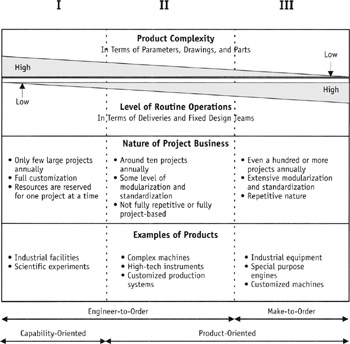Typology of Project Companies
|
Many organizations develop either their project level activities to boost their temporary efforts, or "management by projects" related issues at the level of management of the whole organization. Management by projects refers to an organization's way to conduct its work and tasks in a project form (Turner 1993; Gareis 1994, 1996). A project company (or a project-oriented company) uses either internal [investment] or external [delivery] projects for its business purposes. Internal projects comprise investment projects that may have a nature of investment in systems or facilities, internal development projects, change and reengineering, management of technology and innovation, or research and development (R&D) management. External projects include delivery projects to [external] customers, e.g., deliveries of customer-specific systems or services (Artto 2001). In this study, however, when discussing project companies and their business operations, a project company is described as a mere project supplier company that has [external] delivery projects for its customers in its production line (Artto et al. 1998). Project supplier companies can be considered as analogous organizational entities to any project-oriented organization. The similarity of project-based operations with both external and internal customers is demonstrated by Turner and Keegan (1999), who provided a definition that the project-based organization may be stand-alone, making products for external customers, or a subsidiary of a larger firm, making products for internal or external customers.
In Figure 3, three different categories of project companies are presented. The categorization is based on product complexity and level of routine operations. Companies in the first category (I) produce truly one-of-a-kind products. They develop a unique design each time and deliver the product according to strict customer requirements, i.e., their products are fully customized. Companies in the second category (II) deliver technologically complex products but they are able to modularize and standardize their products to some extent. When some parts of the products can be modularized and standardized, the need for customer-specific engineering is reduced and the design cycles are shortened. The business practices of the companies of the third category (III) are closest to mass customization and mass production. They are able to modularize and standardize their products quite thoroughly but they still have to perform some customer-specific engineering within each delivery. These companies are characterized by the repetitive nature of their deliveries.

Figure 3: Subdivision of Project Companies into Three Categories According to Product Complexity and Level of Routine Operations (adapted from Hameri et al. 1998)
Companies in the first category can be classified as product-oriented, make-to-order companies, companies in the second category are product-oriented, engineer-to-order companies, and companies in the third category are capability-oriented, engineer-to-order companies (Figure 3). It is obvious that companies in the three different categories have a different project scope in their deliveries. Companies in different categories should also have a different stance toward project business. In categories two and three, the resources may not be allocated full-time for a particular project and they must mediate with multiple ongoing projects. Companies in the first category have only a few large projects per year and the resources are usually reserved only for one project at a time. As products are complex and the degree of modularization and standardization is low, the level of project scope is high.
|
EAN: 2147483647
Pages: 207